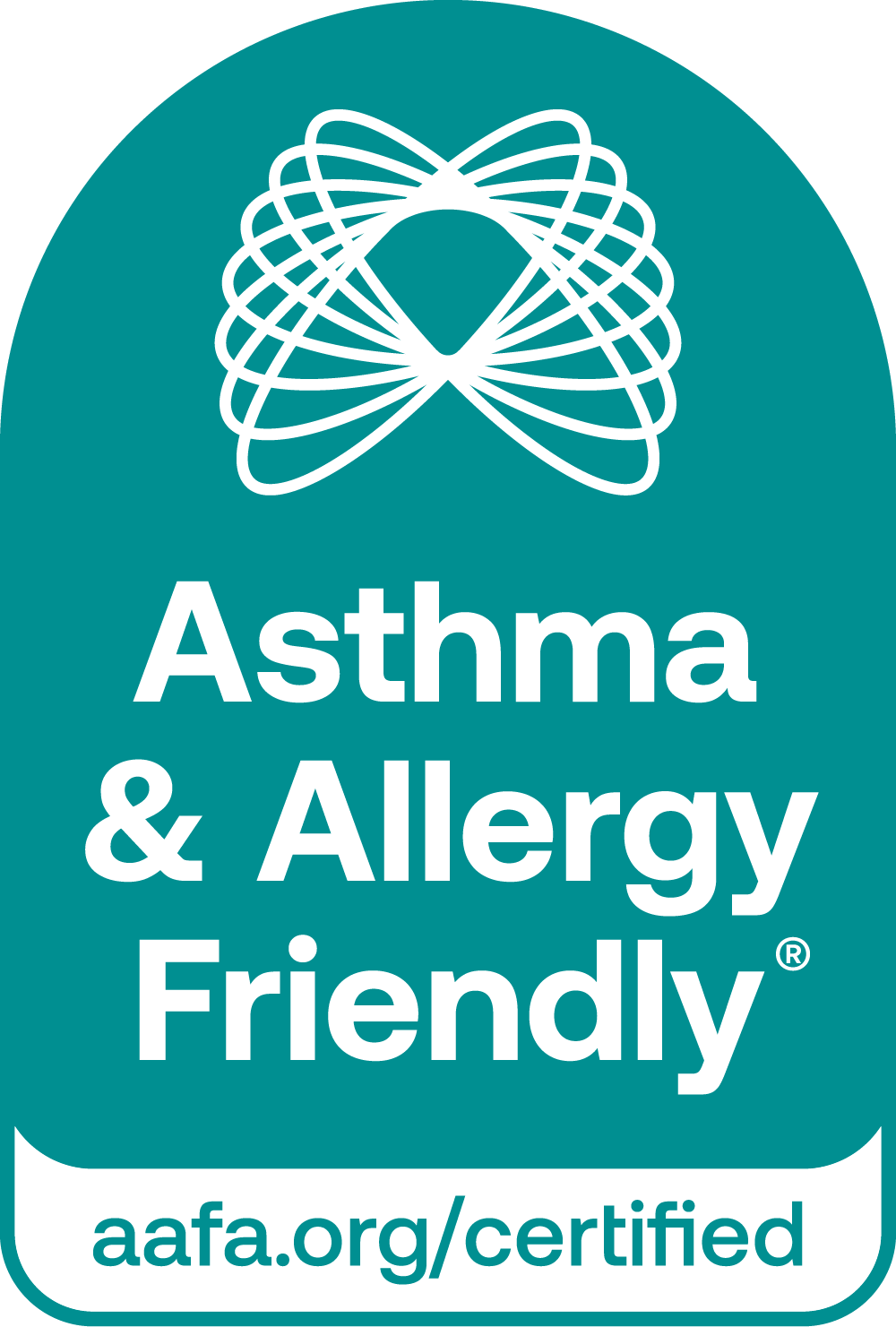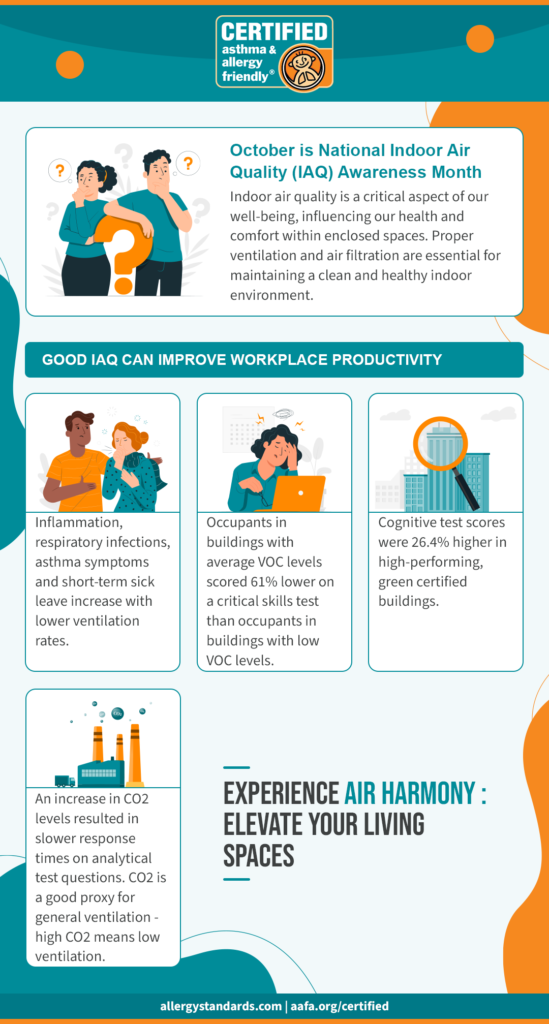Improving indoor air quality with Asthma & Allergy Friendly® Certified products can support healthier workplaces enhancing employee well-being and boosting productivity
When we think about staying healthy at work, we often focus on things like ergonomics, balanced meals, or regular breaks. But there’s another crucial factor we sometimes overlook: the quality of the air we breathe indoors. With so much of our day spent in offices or workplaces, the air circulating inside those spaces plays a key role in both our physical health and cognitive performance. As we highlight October’s National Indoor Air Quality (IAQ) Awareness Month, it’s important to consider how workplace air quality can significantly affect our well-being and what can be done to improve it.
In this article, we will explore the concept of how indoor air quality impacts our health, which elements in the workplace can negatively affect IAQ, and how the Asthma & Allergy Friendly® Certification Program helps ensure that products contribute to a healthier work environment.
Why Indoor Air Quality Impacts Our Health
Indoor Air Quality (IAQ) refers to the air quality within and around buildings and structures, especially as it relates to the health and comfort of building occupants. While most people are aware of outdoor pollution, indoor air can often be two to five times more polluted than the air outside. Given that we spend up to 90% of our time indoors, much of this in workplaces, poor IAQ can significantly impact our health.
Poor IAQ can result in various health problems, ranging from mild symptoms like headaches and fatigue to more severe conditions like respiratory infections and asthma exacerbations. In workplaces with poor ventilation and high levels of indoor pollutants, inflammation, respiratory infections, and short-term sick leave are more common. For people with asthma and allergies, poor IAQ can trigger or worsen their symptoms, leading to increased absenteeism and reduced productivity.
The term ‘Sick Building Syndrome’ (SBS) first became well-known in the 1970s and 80s when many buildings were constructed to be airtight in order to save energy. This airtight design reduced ventilation, leading to poor indoor air quality and causing health problems for some people inside the buildings. Symptoms of SBS include irritation of the eyes, nose, and throat, headaches, fatigue, and sometimes even asthma-like symptoms such as chest tightness or wheezing. What’s interesting about SBS is that these symptoms usually go away once a person leaves the building. Although we don’t hear the term as often today, the problem of poor indoor air quality still exists and many workplaces may unknowingly contribute to these issues.
The link between IAQ and cognitive function is also becoming increasingly clear. Research has shown that occupants in buildings with average levels of volatile organic compounds (VOCs) scored 61% lower on critical skills tests than those in low-VOC environments. Similarly, cognitive test scores were found to be 26.4% higher in green-certified buildings, which typically feature superior ventilation and IAQ. Even an increase in CO2 levels, a proxy for poor ventilation, resulted in slower response times on analytical test questions.
The Role of Evidence-Based Design in Improving Indoor Air Quality
A growing approach in the design world is evidence-based design, which is described by The Centre for Health Design (2022) as “the process of basing decisions about the built environment on credible research to achieve the best possible outcomes.” Originally popularized in healthcare facility design, this approach uses research to guide decisions that positively impact health, comfort, and productivity. One of the most influential studies in this field, conducted by Roger Ulrich in 1984, demonstrated how window views could speed patient recovery. Today, the evidence-based design approach is increasingly being applied to other building types, including workplaces. In the context of indoor air quality (IAQ), evidence-based design allows us to make informed decisions about materials, ventilation, and space layouts, ensuring that these elements contribute to healthier environments for building occupants. By integrating research-backed choices, such as third party certified products, designers and facility managers can create spaces that not only reduce health risks but also improve cognitive performance, employee well-being, and overall productivity.
What Aspects of the Workplace Impact Indoor Air Quality?
Many factors in a workplace can contribute to poor indoor air quality, including building materials, cleaning products, and ventilation systems. Here are some of the key aspects that can affect IAQ:
- Poor Ventilation: Inadequate ventilation is a major contributor to poor IAQ. When fresh air is not brought in to replace stale air, pollutants—particulate matter, VOCs, allergens etc—accumulate indoors. High levels of CO2, a result of poor ventilation, can negatively impact cognitive function and decision-making, as seen in studies where increased CO2 led to slower response times on tests.
- HVAC Systems and Air Filters: Poorly maintained heating, ventilation, and air conditioning (HVAC) systems can contribute to poor IAQ by circulating dust, mold spores, and other pollutants. As these systems move air throughout a building, they can distribute potentially harmful particles if not properly equipped with effective filtration systems. This makes the choice of HVAC filters crucial in managing and improving indoor air quality. Air filters in HVAC systems and portable air cleaners that are not regularly replaced or that do not meet standards can also fail to capture airborne contaminants effectively, allowing allergens and pollutants to build up in the air.
- Volatile Organic Compounds (VOCs): VOCs are chemicals released from many common workplace materials, including paints, flooring, insulation, adhesives, and cleaning products. Exposure to VOCs can cause a variety of health issues, such as eye, nose, and throat irritation, headaches, and long-term respiratory problems. Studies show that high VOC levels in buildings are linked to a significant decrease in cognitive performance.
- Flooring and Insulation: Certain flooring materials and insulation can contribute to poor IAQ by releasing VOCs and trapping dust, allergens, and moisture. These contaminants can easily become airborne, especially when disturbed by foot traffic or poor cleaning practices, further affecting the air quality and the health of occupants. Excess moisture can lead to mold, which can cause respiratory issues even in those without pre-existing conditions.
- Cleaning Products: Many conventional cleaning products contain harsh chemicals that release VOCs and other pollutants into the air. Frequent exposure to these chemicals can aggravate asthma and allergy symptoms, particularly in poorly ventilated spaces. Switching to validated low-VOC or Asthma & Allergy Friendly®Certified cleaning products can significantly reduce these harmful emissions.
How the Asthma & Allergy Friendly® Certification Program CERTIFIES Products for Better IAQ
Given the significant impact that building materials, furnishings, and cleaning products may have on indoor air quality, it’s essential to choose products that are independently verified to support a healthier indoor environment. The Asthma & Allergy Friendly® Certification Program, developed by Allergy Standards Ltd. (ASL) in collaboration with the Asthma and Allergy Foundation of America (AAFA), is a trusted certification that helps consumers and businesses identify products that contribute to better IAQ.
This certification program uses rigorous scientific testing to evaluate a product’s impact on indoor air quality. Products that earn the Asthma & Allergy Friendly® Certification must meet strict standards, ensuring they limit exposure to harmful VOCs and allergens, help reduce the buildup of airborne pollutants, and support better overall air quality in indoor spaces.
Here’s how the certification program evaluates products for IAQ:
- VOC Emissions Testing: Products are tested to measure the levels of VOCs they release over time. Only products that meet low VOC emission limits can earn the certification. This includes not only the product itself but also any adhesives or installation materials that could off-gas into the environment.
- Allergen Reduction: Products are tested for their ability to reduce or trap common indoor allergens, such as dust, pet dander, and mold spores. Certified products must demonstrate that they can be effectively cleaned and maintained to prevent the build-up of allergens.
- Performance and Maintenance: Certified products are also tested for their performance and ease of maintenance, ensuring that they can maintain their health benefits over time without degrading or becoming sources of indoor pollutants.
Why Certified Products Support Healthier Workplaces
Choosing Asthma & Allergy Friendly® Certified products for your workplace can significantly improve indoor air quality and create a healthier environment for all occupants. Here are some of the key benefits of certified products:
- Healthier Work Environment: Certified products are scientifically tested to help reduce allergens and potentially harmful chemicals in the air, thereby reducing asthma and allergy triggers in the workplace. This creates a more comfortable and healthier space for all employees, especially those with pre-existing conditions like asthma and allergies.
- Enhanced Productivity: With studies showing that cognitive test scores are higher in low-VOC and green-certified buildings, using Certified products may help enhance employee focus, decision-making, and overall productivity.
- Support for Sustainability: Many Asthma & Allergy Friendly® Certified products are also more environmentally responsible. Certified Asthma & Allergy Friendly® resilient and textile flooring, paint, and insulation align with the US. Green Building Council’s (USGBC) LEED program and are eligible for credits for low-emitting materials. Additionally, these Certified products are compliant with WELL Feature X06 Part 1b4 of the WELL Building Standard. This helps companies meet sustainability goals while improving IAQ.
Conclusion
Indoor air quality in the workplace is a critical factor that can influence employee health, productivity, and overall well-being. Poor IAQ can lead to a range of health problems, from asthma exacerbations to cognitive issues. However, by choosing Asthma & Allergy Friendly® Certified products, employers can help towards creating more comfortable, healthier workplaces that support better indoor air quality and contribute to the long-term well-being of their employees.
This October, in recognition of National Indoor Air Quality Awareness Month, take a closer look at the products and materials used in your workplace. By selecting Certified products, you’re making a commitment to a healthier, more productive environment for everyone.

